Xanthan Gum Market Outlook - 2032
The global xanthan gum market size was valued at $0.8 billion in 2018, and is projected to reach $1.6 billion by 2032, growing at a CAGR of 5.9% from 2023 to 2032. Rise in demand for gluten-free products, combined with increase in the number of applications of xanthan gum in the food and beverage industry, significantly drives the market growth. As consumers increasingly seek gluten-free alternatives due to dietary restrictions or health preferences, xanthan gum has emerged as a crucial ingredient that mimics the structural properties of gluten in baked goods, enhancing texture and elasticity.
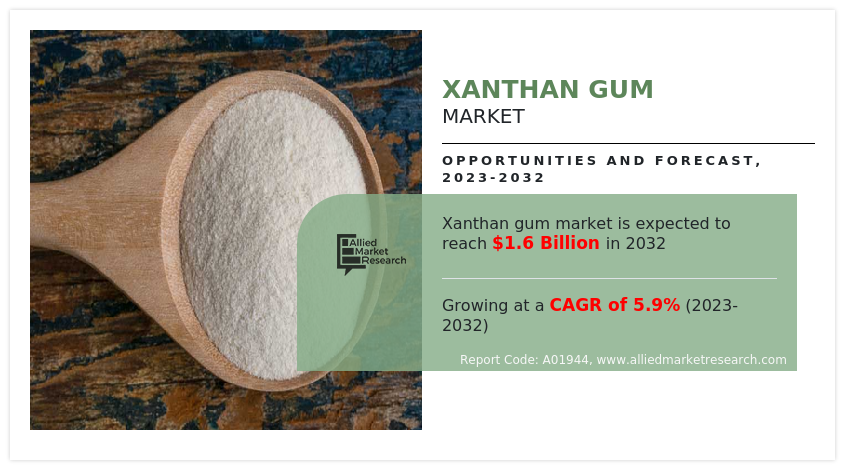
Introduction
Xanthan gum is a polysaccharide widely used in the food, pharmaceutical, and industrial sectors as a thickening and stabilizing agent. It is produced through the fermentation of simple sugars, typically glucose or sucrose, by the bacterium Xanthomonas campestris. This biopolymer has a unique molecular structure that allows it to form a viscous solution even at low concentrations. Xanthan gum is soluble in both hot and cold water, making it highly versatile in various applications.
In the food industry, xanthan gum is commonly used as an additive to improve texture, enhance stability, and extend shelf life. It prevents ingredients from separating, making it particularly useful in products like salad dressings, sauces, and dairy products. In addition, it improves the texture of gluten-free baked goods, compensating for the lack of gluten’s structural properties. Xanthan gum is prized for its ability to maintain its viscosity under a wide range of temperatures, pH levels, and salinity, making it an excellent choice for processed foods.
Key Market Dynamics
Xanthan gum is a polysaccharide, which is a type of complex carbohydrate, which is commonly used as a food additive and thickening agent. Xanthan gum possesses extraordinary properties as a thickener & stabilizer, owing to these properties it is widely utilized in food & beverage applications. In the food industry, xanthan gum helps in the formulation of innovative product development and is widely utilized in salad dressing, bakery products, range of convenience food, soups, sauces, frozen food, and dairy products including many others.
It is an ideal stabilizer to use in salad dressings. In frozen food, it offers better frozen stability, improves texture, and stabilizes emulsions. Furthermore, in bakery products, it improves texture, binds water, and provides easy pourability. Moreover, it is extensively used in low-calorie products to improve texture, bind water, and improve mouthfeel without adding calorie value. All these factors are expected to drive the global xanthan gum industry during the forecast period.
However, the production of xanthan gum involves a fermentation process using specific strains of bacteria, such as Xanthomonas campestris, which requires controlled conditions, advanced technology, and high-quality raw materials such as glucose or sucrose. These raw materials often fluctuate in price, further contributing to production costs. In addition, maintaining the fermentation process at industrial scales demands significant energy consumption, specialized equipment, and skilled labor, all of which increase operational expenses. All these factors are expected to hamper the growth of the xanthan gum market during the forecast period.
As a plant-derived, vegan-friendly ingredient, xanthan gum is widely used in the formulation of dairy and meat alternatives, where it plays a crucial role in enhancing texture, improving mouthfeel, and stabilizing emulsions. The rise of plant-based diets, driven by health-conscious consumers and ethical considerations surrounding animal welfare and sustainability, has increased the need for ingredients that can replicate the texture and stability typically provided by animal-based products like gelatin or eggs. Xanthan gum fulfills this need, making it an essential additive in plant-based food production. All these factors are anticipated to offer new growth opportunities for the global xanthan gum market during the forecast period.
Market Segmentation
The xanthan gum market is segmented into form, grade, end-use industry, and region. On the basis of form, the market is bifurcated into liquid and powder. On the basis of grade, the market is segregated into food grade, industrial grade, pharmaceutical grade, and others. On the basis of end-use industry, it is categorized into food & beverage, oil and gas, pharmaceutical, personal care & cosmetics, and others. On the basis of region, the market is analyzed across North America, Europe, Asia-Pacific, and LAMEA.
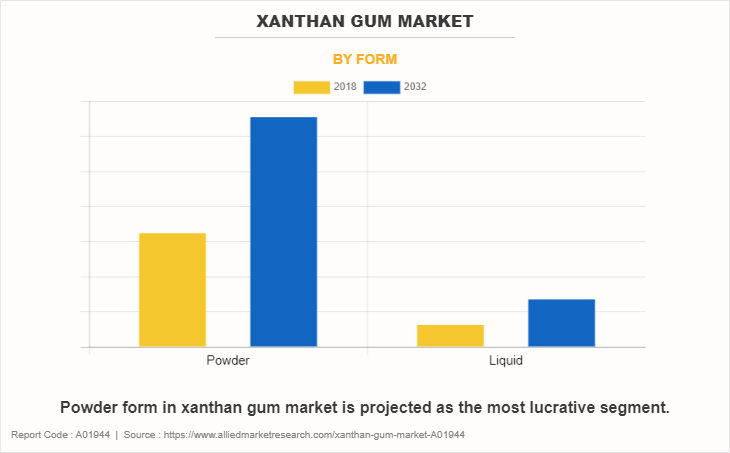
Xanthan Gum Market, By Form
Based on form, the powder xanthan gum segment accounted for the largest share in 2022, contributing to more than four-fifths of the global Xanthan gum market revenue due to xanthan gum is a key ingredient in gluten-free and allergen-free food formulations. It helps replicate the texture and structure that gluten provides in traditional products, making it essential for creating gluten-free alternatives that closely match their conventional counterparts. However, the liquid segment is anticipated to grow at the highest CAGR of 6.2% during the forecast period.
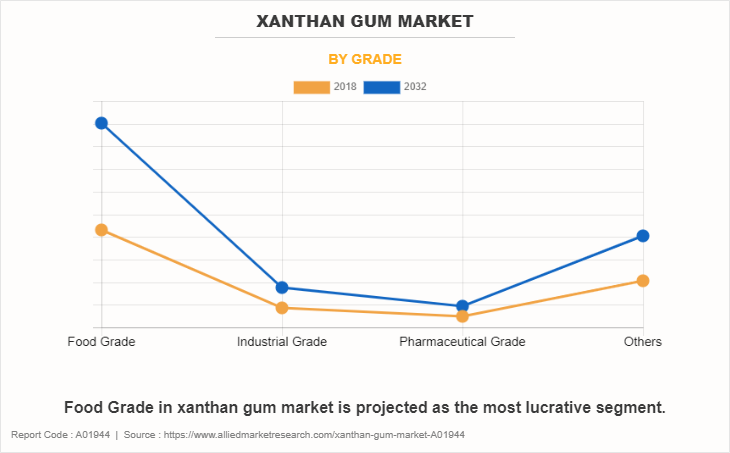
Xanthan Gum Market, By Grade
Based on grade, the food grade segment accounted for the largest share in 2022, contributing to more than half of the global Xanthan gum market revenue, and is anticipated to grow at the highest CAGR of 6.1% during the forecast period due to food safety regulations and standards have become increasingly stringent in many parts of the world. The use of food-grade ingredients and materials is often mandated to ensure that food products are safe for consumption. Businesses are adopting food-grade materials and ingredients to comply with these regulations and to enhance their brand reputation.
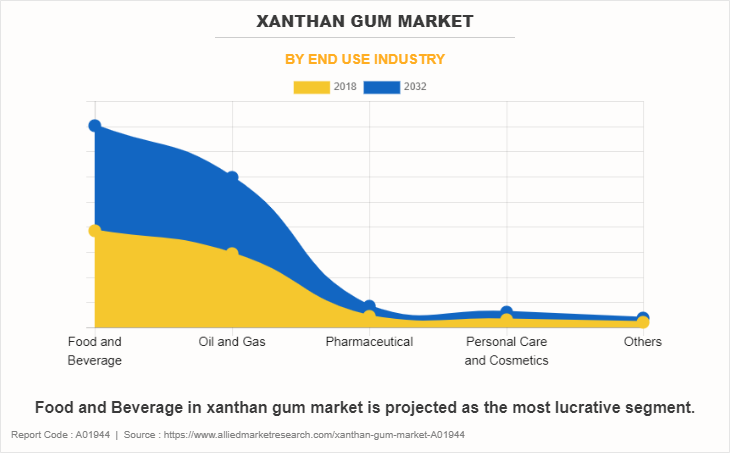
Xanthan Gum Market, By End Use Industry
On the basis of the end-use industry, the construction segment dominated the largest market share in 2022 contributing to more than one-third of the global xanthan gum market revenue and is anticipated to grow at the highest CAGR of 6.0% during the forecast period due to due to the construction industry experiencing growth and increased activity globally. With construction projects taking place around the clock, there is a growing demand for reliable and efficient lighting solutions, including Xanthan gums.
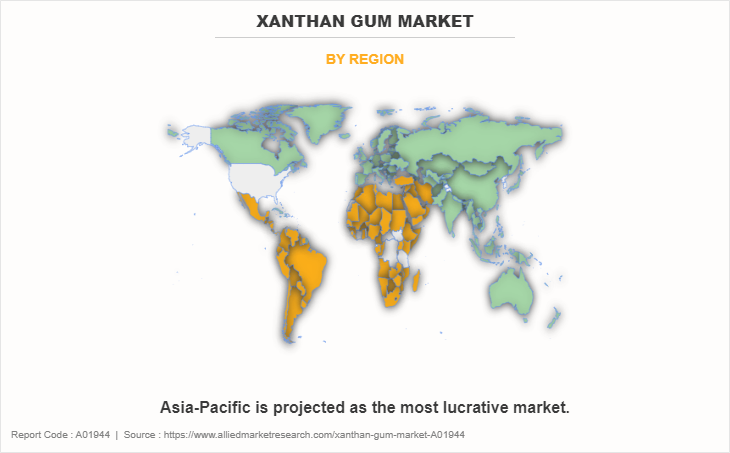
Xanthan Gum Market, By Region
Based on region, Asia-Pacific held the highest market share in terms of revenue in 2022, accounting for more than two-fifths of the global Xanthan gum market and is anticipated to grow at the highest CAGR of 6.1% during the forecast period due to the Asia Pacific region having experienced rapid urbanization and rising disposable incomes, leading to increased demand for processed and convenience food. Applications of xanthan gum in enhancing texture, stability, and quality of these products have driven its demand.
Competitive Analysis
The major players operating in the industry include Cargill Incorporated, DuPont De Nemours, Inc., The Archer-Daniels-Midland Company, Foodchem International Corporation, Deosen Biochemical Ltd., Tate and Lyle PLC, Ingredion Incorporated, CP Kelco ApS, Solvay S.A. and C.E. Roeper GmbH. These players have adopted product launch as their key strategy to strengthen their presence in the market.
Key Benefits For Stakeholders
- This report provides a quantitative analysis of the market segments, current trends, estimations, and dynamics of the xanthan gum market analysis from 2018 to 2032 to identify the prevailing xanthan gum market opportunities.
- In-depth analysis of the xanthan gum market segmentation assists to determine the prevailing market opportunities.
- Major countries in each region are mapped according to their revenue contribution to the global market.
- Market player positioning facilitates benchmarking and provides a clear understanding of the present position of the market players.
- The report includes the analysis of the regional as well as global xanthan gum market trends, key players, market segments, application areas, analysis, and xanthan gum market growth strategies.
Xanthan Gum Market Report Highlights
| Aspects | Details |
| Market Size By 2032 | USD 1.6 billion |
| Growth Rate | CAGR of 5.9% |
| Forecast period | 2018 - 2032 |
| Report Pages | 398 |
| By End Use Industry |
|
| By Form |
|
| By Grade |
|
| By Region |
|
| Key Market Players | Ingredion, Solvay, Tate & Lyle, Foodchem International Corporation, CP Kelco U.S., Inc., Cargill, Incorporated, DuPont, ADM, Deosen Biochemical (Ordos) Ltd., C.E. Roeper GmbH |
Analyst Review
As per the insights of the top-level CXOs, consumers have increasingly sought products with simpler, more natural ingredients. Xanthan gum is derived from fermentation and is considered a clean-label ingredient, which makes it attractive to both manufacturers and consumers looking for recognizable and natural components in products. Furthermore, xanthan gum is used in pharmaceutical formulations as a thickener for oral liquids, suspensions, and gels. Moreover, it helps achieve desirable textures in personal care products such as lotions, creams, and shampoos. Moreover, the demand for products that align with health and wellness trends has driven the use of xanthan gum. It allows manufacturers to create low-fat, reduced-sugar, and lower-calorie versions of products without compromising on texture and mouthfeel. These factors are expected to drive market growth during the forecast period.
However, the cost of producing xanthan gum is influenced by factors such as the availability of raw materials, manufacturing processes, and supply chain disruptions. Price fluctuations in xanthan gum are anticipated to impact its affordability and attractiveness to manufacturers. This factor may restrain market growth during the forecast period.
Xanthan gum's properties, such as its ability to stabilize emulsions and provide a smooth texture, make it valuable in personal care and pharmaceutical products. It is used in products like lotions, creams, and oral medications, leading to its growth in these industries.
food and beverages is the leading end-use industry of Xanthan Gum Market.
Asia-Pacific is the largest regional market for Xanthan Gum.
The Xanthan Gum Market was valued for $0.8 billion in 2018 and is estimated to reach $1.6 billion by 2032, exhibiting a CAGR of 5.9% from 2023 to 2032.
The major players operating in the industry include Cargill Incorporated, DuPont De Nemours, Inc., The Archer-Daniels-Midland Company, Foodchem International Corporation, Deosen Biochemical Ltd., Tate and Lyle PLC Ingredion Incorporated, CP Kelco ApS, Solvay S.A. and C.E. Roeper GmbH.
Loading Table Of Content...
Loading Research Methodology...


